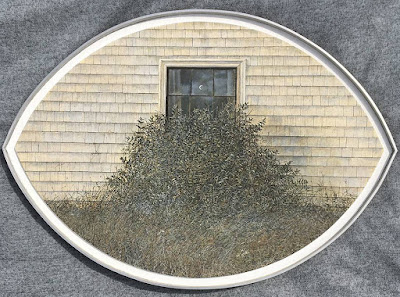To survive in an uninhabited land, you need community. The next crisis may be yours.
 |
| New Puppy, by Carol L. Douglas, 8×10, oil on canvas. |
There’s a vixen that sits on the shoulder of a road here, glorying in the sun. When I first saw her, I thought about calling animal control, because that’s unusual behavior for a fox. I’ve since learned that she took a wire to the muzzle. It became infected and a Good Samaritan fed her antibiotic-laced meat to save her life. Now, she’s a local pet of sorts. A certain person (whose name I won’t mention) gives her dog biscuits. Others feed her Timbits. Still others despair that she’s running with a bad crowd, and her new friends will rob her of the ability to live a normal fox life.
 |
| It’s no surprise that people feed her. She’s cute. |
I’ve lived in my small town in Maine for four years, and I don’t know this much about anything that happens there. And I’m, as they say, plugged in.
Rural Canadians can talk a hind leg off a donkey (I like that). They’re outgoing compared to their New England cousins. It’s not just Nova Scotians, either. On Monday an Edmonton, Alberta man chatted with me as I loaded my car. I now know more about him than I do about either of my neighbors back in Maine.
If I took up all the invitations I’ve received, I’d never get home. A man showed me photos of his spectacular view. He’d moved here from Hamilton, Ontario. “That’s a six-million-dollar view back home,” I said. He nodded enthusiastically. He really wants artists to come paint it.
 |
| Pink sand, by Carol L. Douglas, 8×10, oil on canvas. |
Almost one in four Canadians live in the so-called
Golden Horseshoe that wraps around Toronto (which includes Hamilton). Four of five Canadians live in cities. The rest of Canada is essentially empty. Rural Canadians can’t afford to be stand-offish. To survive in what is essentially a wilderness, you need to cultivate community. The next disaster or crisis may be yours.
Parrsboro, with a population of 1,205, is a regional hub in Cumberland County. It has a small co-op and a Pharmasave, along with a smattering of other businesses. The town is a third the size it was a century ago, but that doesn’t mean it’s going “gentle into that good night.”
 |
| The Black House, by Carol L. Douglas. This was my attempt at chiller-thriller, but my boy model was so busy pounding his friend I never asked him if he found the black house scary. |
On Monday I drove to
Lunenburg, which is south of Halifax on Nova Scotia’s
South Shore. This is the home of the
Smith & Rhuland Shipyard, where
Bluenose was built. My father had a pleasure craft built in Nova Scotia to a
Roué design, so it was a pilgrimage for me. It’s also the home port for
Bluenose II and
Picton Castle, although both boats were, perversely, in Buffalo at the time.
It’s a lovely little town, with opportunities for great painting, but it reminded me powerfully of Camden. In other words, there are too many tourists milling around. I’ll be back during the shoulder season, but for now I prefer the ranginess of Parrsboro.
I’m not alone. On Saturday, I met an artist from Halifax, in Parrsboro for a workshop. “I love it here,” she said wistfully. “I could live here.” Perhaps someday, she will.





